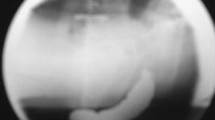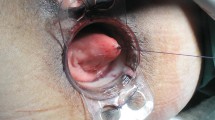Abstract
Purpose
Obstructed defecation may be treated by stapled transanal rectal resection, but different complications and recurrence rates have been reported. The present study was designed to evaluate stapled transanal rectal resection results, outcome predictive factors, and nature of complications.
Methods
Clinical and functional data of 123 patients were retrospectively analyzed. All patients had symptoms of obstructed defecation before surgery and had rectocele and/or intussusception. Of them, 85 were operated on by the authors and 38 were referred after stapled transanal rectal resection had been performed elsewhere.
Results
At a median follow-up of 17 (range, 3–44) months, 65 percent of the patients operated on by the authors had subjective improvement. Recurrent rectocele was present in 29 percent and recurrent intussusception was present in 28 percent of patients. At univariate analysis, results were worse in those with preoperative digitation (P < 0.01), puborectalis dyssynergia (P < 0.05), enterocele (P < 0.05), larger size rectocele (P < 0.05), lower bowel frequency (P < 0.05), and sense of incomplete evacuation (P < 0.05). Bleeding was the most common perioperative complication occurring in 12 percent of cases. Reoperations were needed in 16 patients (19 percent): 9 for recurrent disease. In the 38 patients referred after stapled transanal rectal resection, the most common problems were perineal pain (53 percent), constipation with recurrent rectocele and/or intussusception (50 percent), and incontinence (28 percent). Of these patients, 14 (37 percent) underwent reoperations: 7 for recurrence. Three patients presented with a rectovaginal fistula. One other patient died for necrotizing pelvic fasciitis.
Conclusions
Stapled transanal rectal resection achieved acceptable results at the cost of a high reoperation rate. Patients with puborectalis dyssynergia and lower bowel frequency may do worse because surgery does not address the causes of their constipation. Patients with large rectoceles, enteroceles, digitation, and a sense of incomplete evacuation may have more advanced pelvic floor disease for which stapled transanal rectal resection, which simply removes redundant tissue, may not be adequate. This, together with the complications observed in patients referred after stapled transanal rectal resection, suggests that this procedure should be performed by colorectal surgeons and in carefully selected patients.

Similar content being viewed by others
References
Boccasanta P, Venturi M, Stuto A, et al. Stapled transanal rectal resection for outlet obstruction: a prospective, multicenter trial. Dis Colon Rectum 2004;47:1285–96.
Shorvon PJ, McHugh S, Diamant NE, Somers S, Stevenson GW. Defecography in normal volunteers: results and implications. Gut 1989;30:1737–49.
Dvorkin LS, Gladman MA, Epstein J, Scott SM, Williams NS, Lunniss PJ. Rectal intussusception in symptomatic patients is different from that in asymptomatic volunteers. Br J Surg 2005;92:866–72.
Mimura T, Roy AJ, Storrie JB, Kamm MA. Treatment of impaired defecation associated with rectocele by behavioural retraining (biofeedback). Dis Colon Rectum 2000;43:1267–72.
Hwang YH, Person B, Choi JS, et al. Biofeedback therapy for rectal intussusception. Tech Coloproctol 2006;10:11–6.
Vermeulen J, Lange JF, Sikkenk AC, van der Harst E. Anterolateral rectopexy for correction of rectoceles leads to good anatomical but poor functional results. Tech Coloproctol 2005;9:35–41.
Zacharin FR, Hamilton NT. Pulsion enterocele: long-term results of an abdominoperineal technique. Obstet Gynecol 1980;2:141–8.
Lieberman H, Hughes C, Dippolito A. Evaluation and outcome of the Delorme procedure in the treatment of rectal outlet obstruction. Dis Colon Rectum 2000;43:188–92.
Brown AJ, Anderson JH, McKee RF, Finlay IG. Surgery for occult rectal prolapse. Colorectal Dis 2004;6:176–9.
Corman ML, Carriero A, Hager T, et al. Consensus conference on the stapled transanal rectal resection (STARR) for disordered defaecation. Colorectal Dis 2006;8:98–101.
Boccasanta P, Venturi M, Salamina G, Cesana BM, Bernasconi F, Roviaro G. New trends in the surgical treatment of outlet obstruction: clinical and functional results of two novel transanal stapled techniques from a randomised controlled trial. Int J Colorectal Dis 2004;19:359–69.
Renzi A, Izzo D, Di Sarno G, Izzo D, Di Martino N. Stapled transanal rectal resection to treat obstructed defecation caused by rectal intussusception and rectocele. Int J Colorectal Dis 2006;13:1–7.
Dodi G, Pietroletti R, Milito G, Binda G, Pescatori M. Bleeding, incontinence, pain and constipation after STARR transanal double stapling rectotomy for obstructed defecation. Tech Coloproctol 2003;7:148–53.
Pescatori M, Dodi G, Salafia C, Zbar AP. Rectovaginal fistula after double-stapled transanal rectotomy (STARR) for obstructed defaecation. Int J Colorectal Dis 2005;20:83–5.
Binda GA, Pescatori M, Romano G. The dark side of double-stapled transanal rectal resection. Dis Colon Rectum 2004;47:1285–6.
Jayne DG, Finan PJ. Stapled transanal rectal resection and evidence based practice. Br J Surg 2005;92:793–4.
Mellgren AF, Zetterstrom J, Lopez A. Rectocele. In: Wexner SD, Zbar AP, Pescatori M. Complex anorectal disorders. London: Springer-Verlag, 2005:446–60.
Infantino A, Masin A, Melega E, Dodi G, Lise M. Does surgery resolve outlet obstruction from rectocele? Int J Colorectal Dis 1995;10:97–100.
Olsen AL, Smith VJ, Berstrom JO, Colling JC, Clark AL. Epidemiology of surgically managed pelvic organ prolapse and urinary incontinence in a population-based managed care setting. In: Proceedings of the Seventeenth Annual Meeting of the American Urogynecologic Society. New Orleans, Louisiana, October 4–7, 1996.
Roman H, Michot F. Long term outcomes of transanal rectocele repair. Dis Colon Rectum 2005;48:510–7.
Ho YH, Cheong WK, Tsang C, et al. Stapled hemorrhoidectomy: cost and effectiveness. Randomized, controlled trial including incontinence scoring, anorectal manometry and endoanal ultrasound assessment at up to three months. Dis Colon Rectum 2000;43:1666–75.
Senagore A, Gallagher J, Hull T, Ferrara A. A short-term assessment of the efficacy of the STARR procedure for obstructed defecation syndrome [abstract]. Dis Colon Rectum 2005;48:634.
van Dam JH, Schouten WR, Ginai AZ, Huisman WM, Hop WC. The impact of anismus on the clinical outcome of rectocele repair. Int J Colorectal Dis 1996;11:238–42.
Tjandra JJ, Ooi B-S, Tang C-L, Dwyer P, Care M. Transanal repair of rectocele corrects obstructed defecation if it is not associated with anismus. Dis Colon Rectum 1999;42:1544–50.
Cheetham MJ, Mortensen NJ, Nystrom P-O, Kamm MA, Phillips RK. Persistent pain and faecal urgency after stapled hemorrhoidectomy. Lancet 2000;356:730–3.
Nisar PJ, Acheson AG, Neal KR, Scholefield JH. Stapled hemorrhoidopexy compared with conventional hemorrhoidectomy: systematic review of randomized, controlled trials. Dis Colon Rectum 2004;47:1837–45.
Thaha MA, Irvine LA, Steele RJ, Campbell KL. Postdefaecation pain syndrome after circular stapled anopexy is abolished by oral nifedipine. Br J Surg 2005;92:208–10.
Pruyn SC. Acute necrotizing fasciitis of the endopelvic fascia. Obstet Gynecol 1978;52(1 Suppl):25–45.
Gallup DG, Freedman MA, Meguiar RV, Freedman SN, Nolan TE. Necrotizing fasciitis in gynecologic and obstetric patients: a surgical emergency. Am J Obstet Gynecol 2002;187:305–10.
Maw A, Eu KW, Seow-Choen F. Retroperitoneal sepsis complicating stapled hemorrhoidectomy: report of a case and review of the literature. Dis Colon Rectum 2002;45:826–8.
Molloy RG, Kingsmore D. Life-threatening pelvic sepsis after stapled haemorrhoidectomy. Lancet 2000;355:810.
Corman ML. Operative approaches to the treatment of hemorrhoids. In: Corman ML. Colon and rectal surgery. Philadelphia: Lippincott Williams & Wilkins, 2005:226–7.
Mercer-Jones M, Sprowson A, Varma J. Outcome after transperineal mesh repair of rectocele: a case series. Dis Colon Rectum 2004;47:864–8.
Pescatori M, Boffi F, Russo A, Zbar AP. Complications and recurrence after excision of rectal internal mucosal prolapse for obstructed defaecation. Int J Colorectal Dis 2006;21:160–5.
Thornton MJ, Lam A, King DW. Laparoscopic or transanal repair of rectocele? A retrospective matched cohort study. Dis Colon Rectum 2005;48:792–8.
Cundiff GW, Harris RL, Coates K, et al. Abdominal sacral colpoperineopexy: a new approach for correction of posterior compartment defects and perineal descent associated with vaginal vault prolapse. Am J Obstet Gynecol 1997;177:1345–55.
Richardson AC. The rectovaginal septum revisited: its relationship to rectocele and its importance in rectocele repair. Clin Obstet Gynecol 1993;36:976–83.
Petersen S, Hellmich G, Schuster A, et al. Stapled transanal rectal resection under laparoscopic surveillance for rectocele and concomitant enterocele. Dis Colon Rectum 2006;49:1–5.
Aumann G, Petersen S, Pollack T, Hellmich G, Ludwig K. Severe intra-abdominal bleeding following stapled mucosectomy due to enterocele: report of a case. Tech Coloproctol 2004;8:41–3.
Ekberg O, Nylander G, Fork FT. Defecography. Radiology 1985;155:45–8.
Acknowledgements
The authors thank Drs. F. Bianco, M. Gargiani, and G. Tessera for their help with data collection.
Author information
Authors and Affiliations
Consortia
Corresponding author
Additional information
Read at the meeting of The American Society of Colon and Rectal Surgeons, Seattle, Washington, June 3 to 7 2006.
Reprints are not available.
About this article
Cite this article
Gagliardi, G., Pescatori, M., Altomare, D.F. et al. Results, Outcome Predictors, and Complications after Stapled Transanal Rectal Resection for Obstructed Defecation. Dis Colon Rectum 51, 186–195 (2008). https://doi.org/10.1007/s10350-007-9096-0
Received:
Revised:
Accepted:
Published:
Issue Date:
DOI: https://doi.org/10.1007/s10350-007-9096-0




